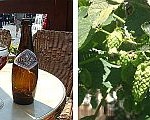Beer Antioxidants: Xanthohumol
 This post is something near and dear to my heart, beer. We’ve all heard about the fantastic antioxidants in red wine; namely resveratrol. However, beer has the potential to equal or exceed red wine in antioxidant potential. We’re not talking about your mass produced “Lite” beers. No, we’re talking extremely hoppy and dark beers with robust and bitter tastes. I would tell you to stop reading now if, unlike me, you make a sour face at seeing, smelling and tasting such things as stouts, porters, strong IPA’s, cloudy unfiltered brews and their ilk. However, like red wine there may be an alternative in supplement form.
This post is something near and dear to my heart, beer. We’ve all heard about the fantastic antioxidants in red wine; namely resveratrol. However, beer has the potential to equal or exceed red wine in antioxidant potential. We’re not talking about your mass produced “Lite” beers. No, we’re talking extremely hoppy and dark beers with robust and bitter tastes. I would tell you to stop reading now if, unlike me, you make a sour face at seeing, smelling and tasting such things as stouts, porters, strong IPA’s, cloudy unfiltered brews and their ilk. However, like red wine there may be an alternative in supplement form.
Antioxidant Sources in Beer
One researcher, Biochemist John Trevithick, was surprised to find that while red wine contained 20 times more polyphenols than beer, one drink of stout produced the same plasma antioxidant increase as a drink of red wine in his human subjects.
Beer has antioxidants that are the result of three ingredients: hops, barley and yeast. These are in the general class of polyphenols. While red wine also contains polyphenols; beer contains an unique class of polyphenols due to the hops.
The barley malt used in the beer brewing process is a rich source of polyphenols with antioxidant properties. Typically the darker the beer the greater the antioxidant power. This is due to the roasting process and its alteration in the polyphenol structures.
Yeast used in the beer brewing process provides B vitamins and probiotics to the imbiber. While yeast is used in the wine making process it is filtered out before bottling. Some beers are unfiltered and some even add yeast again before bottling.
Hop’s Super Star Antioxidant: Xanthohumol
Hops are what contribute to beer’s bitter bite and contain an interesting class of polyphenols called prenylated flavonoids. We’ve all heard of flavonoids but probably a lot of us are not familiar with prenylated flavonoids. They’re called prenylated because the flavonoid has a prenyl chemical group attached to it which is hydrophobic in nature. This simply means in does not dissolve in water. According to the Wikipedia entry this may facilitate its attachment to cell membranes which are highly vulnerable to attack by free radicals. It may also lend greater stability in the body and its concentration in cells.
Xanthohumol (zan-tho-HUGH-mol), is the star of the prenylated flavonoids in beer. Of all the antioxidant beverages, xanthohumol is unique to beer but is present in only small amounts. Dr. Donald R. Buhler with the Linus Pauling Institute at Oregon State University has done extensive work with plant flavonoids. He found that in the test tube xanthohumol exhibited potent antioxidant properties.
Research at Tokushima University led by professor Junji Terao found that rats with paralyzed legs fed prenylated flavonoids maintained their muscle mass which has implications to preventing muscle atrophy in people due to aging and for those looking to increase muscle mass.
Other research in rats and in the test tube suggest that xanthohumol can have positive effects against everything from diabetes, cancer, heart disease and aging.
Xanthohumol Supplementation
Supplement companies have jumped on the positive research on xanthohumol and produced it in pill form. One company offers a standardized extract of hops containing 10% xanthohumol for a total of 50 mg/capsule.
So you’ll hear things from the supplement industry along the lines of, “You would need to drink 5000 gallons of beer to get the same level of xanthohumol used in so-and-so study performed in rats.” Same thing we heard with resveratrol and the thousands of gallons of red wine we would need to drink to get the same amount of resveratrol used is so-and-so study done in rats.
One should be aware that the research mentioned earlier in this report of beer’s benefit on antioxidant plasma levels was only evident with one or two drinks. Three beers not only didn’t have the beneficial effect; it actually showed a pro-oxidant effect. That is it produced free radicals! And this wasn’t because of the increased alcohol intake since in happened also with non-alcoholic beer.
So imagine what might happen with concentrating the amount of polyphenols of 50 to 100 beers in one capsule!
Antioxidants have the capacity to become pro-oxidants when taken in high concentrations due to a process known as auto-oxidation and/or by disturbing the delicate antioxidant/oxidant balance in the body.
The Best Beer Choices for Antioxidant Power
Choose craft beers that use a lot of hops in the brewing process. Sierra Nevada makes a beer called Hoptimum that uses a variety of hopping processes. Deutsches Brewery’s Hop In The Dark Cascadian Dark Ale combines the dual antioxidant power of dark beer that is heavily hopped.
And remember, moderation, moderation, moderation.

One Comment
spankbang
It reduces problems related to the menopause and pre-menopause. Hop flowers contain the most powerful phytooestrogen isolated to date: 8-Prenylnaringenin. It acts as a selective modulator of oestrogen receptors, helping to reduce discomfort associated with the menopause, such as hot flushes. In addition, xanthohumol is a powerful inhibitor of the bone resorption responsible for osteoporosis.